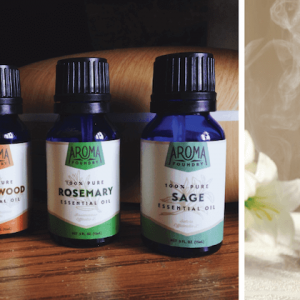
Most people don’t take any second-guesses when it comes to relieving pain. The first thing most people do is pop a pill and get on with their day. But what if you could relieve pain in a safer, more effective way? That’s where pain-relieving essential oils come in.
Essential oils have the ability to provide relief to those who suffer from pain, whether it is chronic or acute. How? They penetrate the skin quickly and provide nutrients, oxygen (through increased circulation), and beneficial anti-inflammatories to our most painful areas.
While essential oils and pain-killers differ in their mode of application (one you swallow, one you apply topically), it doesn’t mean that one works better than the other. If we put essential oils on our skin, do these oils enter our body? Of course! In fact, studies have found that essential oils and their components are rapidly absorbed through the skin and are detectable in plasma after topical application (1).
This makes topical dermal deliver of essential oils an effective method to directly provide a natural, anti-inflammatory agent to the site of inflammation.
What Kind of Pain Can You Use Essential Oils For?
Depending on the severity of the pain, my top 10 pain-relieving essential oils can be applied one of two ways.
1. Acute Pain
If you’re suffering from acute pain (a burn, twisted ankle, broken bone, etc.), apply the oil undiluted (100% strength) to the affected area. After the injury has calmed down a little bit, you’ll want to dilute any further essential oil applications to about 20% with a carrier oil (described below). Continue using the diluted essential oil until acute pain is gone (or the injury has healed).
2. Chronic Pain
For chronic pain (such as with those who have autoimmune disease, arthritis, fibromyalgia, etc.), you will want to always dilute your essential oils, as you’ll probably be using them for a very long time. Start with a low dilution (like 5% – e.g., 5 drops of jojoba oil to 1 drop essential oil), and then work your way up to 10% dilution, 20% dilution and so forth.
How To Use Essential Oils
When using essential oils, never go overboard. Just remember that a little goes a long way. High levels of essential oils might cause reactions and sensitivity, so be sure to do a skin patch check before using them on a regular basis. You also want to take caution if you have any existing heart conditions, or if you’re taking blood pressure medications. Always talk to your doctor before beginning a new treatment.
One of the safest ways to use essential oils is by diluting them with a carrier oil like almond seed oil, jojoba oil, grapeseed oil, or apricot kernel seed oil. The way I do it is put a little bit of a carrier oil into the palm of my hand (about 1/2 tsp.) and then put around 3-5 drops of whatever essential oil I am using and mix it all up before applying.
Also, make sure that the brand of your essential oils are 100% pure. I always suggest oils made by Eden’s Garden or Mountain Rose Herbs, as they produce high-quality oils.
Top 10 Pain-Relieving Essential Oils
Here are the 10 most beneficial pain-relieving essential oils for all your aches and pains.
1. Copaiba
Copaiba essential oil contains the cannabinoid beta-caryphyllene (BCP), and it specifically targets CB2 receptors, which aids in the reduction of inflammation and pain. Copaiba contains very high concentrations of BCP, and studies have found that BCP relieves chronic pain and neuropathy (2), reduces muscle spasms and muscle pain, and can be applied locally to reduce pain (3). I personally love using copaiba for pain relief, and my mother uses it to relieve arthritic pain. It doesn’t smell like much, and I find it isn’t as intense as other oils, and so it doesn’t irritate the skin as much.
2. Rosemary
Rosemary essential oil is extremely high in antioxidants, and is rich in anti-inflammatory and anti-spasmodic properties. Rosemary contains the antioxidant, carnosol, which has been studied for not only its powerful anti-cancer properties, but anti-inflammatory properties. Studies have provided evidence that carnosol targets multiple deregulated pathways associated with inflammation and cancer that include nuclear factor kappa B, apoptotic related proteins, phosphatidylinositol-3-kinase/Akt, androgen and estrogen receptors, as well as molecular targets (4). This makes rosemary one of the most beneficial pain-relieving essential oils out there.
3. Helichrysum
When applied topically, helichrysum can work for almost any kind of pain involving the muscles, joints, tendons and ligaments. The hypotensive action of helichrysum improves the condition of blood vessels by lowering inflammation, lowering blood pressure and increasing smooth muscle function (5). Research also indicates that helichrysum oil decreases muscle pain by lowering swelling, inflammation and improving circulation. This makes it an effective natural pain-relieving treatment for pain-related symptoms of arthritis, fibromyalgia and injuries.
4. Ginger
While many people are aware of fresh ginger root and ginger powder, not many people are aware of ginger essential oil. Given the major anti-inflammatory effects of ginger root, you can only imagine the concentrated inflammation-busting properties of ginger in essential oil form. Ginger provides pain relief by acting on vanilloid receptors, which are located on sensory nerve endings (6). Studies have even found that ginger extract could be a substitute to non-steroidal anti-inflammatory drugs (7). Ginger also has small amounts of analgesic properties, making it great for anyone dealing with lots of pain.
5. Turmeric
Similar to ginger, who knew that turmeric essential oil existed?! I sure didn’t, at least, not until I decided to look it up one day. And if you haven’t already heard, turmeric is one of the best anti-inflammatory herbs around. Turmeric contains the active compound called curcumin, which inhibits the activity of interleukin (IL)-6, an inflammatory cytokine known to be involved in the case of rheumatoid arthritis (8). Turmeric has also been compared to work just as well, if not better than conventional pain-killers like ibuprofen (9). Need I say more?
6. Frankincense
Frankincense essential oil is known as the “King of Oils” for good reason. By regulating inflammation, frankincense oil not only helps acute pain, but is a great option for those with chronic pain. In 2014, researchers wanted to support the Omani traditional uses of frankincense for muscle, stomach and arthritic pain. Of the various preparations tested, frankincense oil showed the strongest pain-inhibiting results with over 50% in both early and late phase pain (10). Not to mention, frankincense smells amazing – so you can battle pain while smelling good, too!
7. Myrrh
Two primary active compounds are found in myrrh, called terpenoids and sesquiterpenes, both of which have anti-inflammatory and antioxidant effects (11). Studies have found that myrrh works even better when combined with frankincense. The study that looked into the beneficial effects of combining frankincense and myrrh found that when used together, inflammation was dramatically reduced (12).
8. Orange
Orange essential oil has been widely studied for its beneficial effects in fighting pain. A study published in the European Journal of Medical Research investigated the antioxidant potential of various essential oils, and found that orange essential oil was one of the most effective of those studied (13). And besides, who wouldn’t want to smell like an orange all day? Citrus scents help you feel more awake and energized – the perfect combination for early mornings.
9. Spruce
Spruce essential oil is highly affective for those dealing with joint pain. It is rich in monoterpenes, which give this oil its anti-inflammatory and analgesic therapeutic effects. It is also known to help deodorize the air, and help decongest the lungs. It is excellent for anyone dealing with inflammation of the lungs such as asthma and bronchitis.
10. Palo Santo
If you’re looking to naturally lower pain from arthritis, injuries, or chronic back or neck pain, all you need is a little palo santo. It contains a rich supply of antioxidants and phytochemicals called terpenes, including limonene (the natural kind) and alpha-terpineol. This makes palo santo an effective oil for fighting free radical damage (oxidative stress), relieving stomach aches, reducing pains due to arthritis, and acting as a natural cancer treatment.









What is the best site to purchase these Essential Oils?
I personally love Eden’s Garden, or Mountain Rose Herbs.
Thank you
Can you combine these oils to address multiple issues?
Of course! I combine oils all the time.